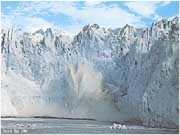|
Methane
Buildup Predicted
in Superstorm Book Confirmed
12-Jul-2001
from
UnknownCountry Website
Scientists have discovered that the same
massive release of methane into the atmosphere that caused sudden
climate change 14,000 years ago has already started to happen again.
At that time, there was a sudden, devastating change in earth’s
climate. It took place when dramatic drops in temperature followed
an equally dramatic temperature spike. Naturally occurring global
warming had been taking place for some time, when a massive release
of methane into the atmosphere sped the process up, causing a
worldwide spike in temperatures.
|

Melting Glacier
|
This caused a devastating acceleration in global warming, triggering
warming processes that melted most of earth's polar ice and raised
sea levels world-wide, engulfing coasts and drowning islands.
Art
Bell and Whitley Strieber, in their book the Coming Global Superstorm, identified this methane release as one of the key
triggers of the dramatic heating that led to the subsequent
climactic chaos that broke out during that period.
Santo Bains of Oxford University’s Department of Earth Sciences led
a team of geologists through three years of research in the badlands
of Wyoming. They also took samples from the ocean floors off Florida
and Antarctica.
Their study confirms work by Russian,
French and US scientists studying ancient air bubbles trapped in
Greenland and Antarctic ice-cores. This data all show that global
warming at the end of the last Ice Age 14,000 years ago was also
associated with a huge and very rapid increase of methane into the
atmosphere.
Methane retains far more heat in the atmosphere than does carbon
dioxide. Large amounts of methane are trapped in and below the
permafrost in the Arctic. Also, sediments in sea beds worldwide
contain vast quantities of methane hydrates and trapped methane gas.
Cold temperatures keep them stable, but permafrost melt is already
beginning to release methane, and the hotter the arctic gets, the
more methane will enter the atmosphere.
This is the same process that took place 14,000 years ago.
In addition, as global warming raises sea levels, large areas of
Siberian and other permafrost areas will be flooded, releasing yet
more methane. Global warming will then become a self- feeding cycle,
unstoppable by any form of human intervention.
The major natural cause of massive methane escape comes from buried
ocean reserves. When underwater landslides expose previously buried
gas-bearing sediments, pressure is reduced in an instant and the gas
escapes into the atmosphere.
Scientists are only now beginning to
realize that global warming can increase the rate of these marine
landslides.
Because global warming creates a warmer and wetter world
in which floods are more likely to occur, the volume and flow of
many rivers will increase, and increased river flow creates larger
expanses of methane-producing swamps.
“The new evidence clearly shows
methane was deeply involved in the very rapid global warming at
the end of the ice age,” says Professor Euan Nisbet, of the
University of London. “By studying that event, we may well be
able to understand the effect of future global warming on the
Arctic.”
There is another major factor which has
been left out of most global warming predictions. Although most
areas of the world will become wetter as global warming continues,
one key area, the Amazon Basin, could become drier, according to a
British Meteorological Office study. As a result, the jungle would
be unable to survive and would begin to die.
This would accelerate
global warming in two ways.
-
First, as the jungle dries up, it would become flammable and
vulnerable to massive forest fires caused by lightning. This would
release up to 150 billion tons of CO2 into the
atmosphere.
-
Second, the destruction of the jungle and its
replacement by savanna grassland would reduce the planet's ability
to absorb CO2 more profoundly than scientists had
realized.
Four Brazilian biologists, led by Dr Antonio Nobre of Brazil's
National Institute for the Study of the Amazon, have made the
surprising discovery that the number of plants in the Amazon jungle
has been increasing in response to human CO2 emissions.
Thus the Amazon is reducing the rate of
global warming much more than science realized. If the jungle
disappears - and climatologists warn that could happen between 2050
and 2100 - its disappearance would have an even more bigger effect
than we’ve planned for.
Back to Contents
Back to Climate Changes
|
